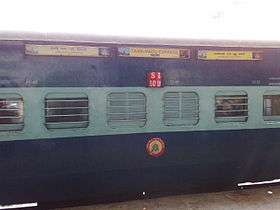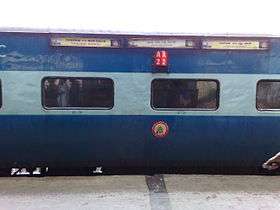Tamil Nadu Express
 | |||||
| Overview | |||||
|---|---|---|---|---|---|
| First service | August 7, 1976 | ||||
| Current operator(s) | Indian Railways | ||||
| Route | |||||
| Start | Chennai Central | ||||
| Stops | 10 | ||||
| End | New Delhi | ||||
| Distance travelled | 2,184 km (1,357 mi) | ||||
| Average journey time | 32 hours | ||||
| Service frequency | Daily | ||||
| Train number(s) | 12621 / 12622 | ||||
| On-board services | |||||
| Class(es) | AC 1st Class, AC Two Tier, AC Three Tier, Sleeper Class | ||||
| Seating arrangements | Yes | ||||
| Sleeping arrangements | Yes | ||||
| Catering facilities | Yes | ||||
| Observation facilities | LHB Coaches | ||||
| Technical | |||||
| Track gauge | 1,676 mm (5 ft 6 in) | ||||
| Operating speed | 71 km/h (44 mph) average without halts. | ||||
| |||||
The Tamil Nadu Express or T.N. Express is a passenger train route of the Indian Railways. The train was first started on 7 August 1976 by then Prime Minister, Indira Gandhi.[1] Introduced as a tri-weekly, it was the first State named train of the south. It runs between Chennai Central and New Delhi. It is considered as the fastest non-Rajdhani Express train. In 1976, it was a tri weekly train, then made four times a week just before the 1982 Asian Games and then converted to a daily train by Madhav Rao Scindia in June 1988 and who added Gwalior to the stoppages.[2] Numbered 12621/12622, this train belongs to the Superfast category of Indian Railways.
History
When first introduced, the train was numbered 121/122 and the train had 13 compartments and was hauled by a single WDM 2 locomotive. After the Madras to Vijayawada line was electrified, the train was hauled by a single WAM 4 electric on that stretch, and a single WDM 2 from Vijayawada to New Delhi. When the Chennai - New Delhi line was partially electrified in the late 1980s, it had to change engines twice in the route, from WAM 4 to WDM 2 at Vijayawada and then from WDM 2 to WAM 4 at Itarsi Junction.[2] When it was a non-daily train, it shared time slots with Andhra Pradesh Express and Kerala Express. The train from Delhi previously split at Katpadi (Vellore) or Jolarpettai, with corresponding train sets departing to Bangalore and Trivandrum (now called Thiruvananthapuram). Similarly, the two portions used to combine at one of these stations and operate to New Delhi.
The first Superfast to connect the Southern Metro with the state capital the train beat the record of G T Express which held the superfast train status of the South that time and fastest to reach New Delhi. Timings were not convenient for Delhi travelers, leading to daily and timings altered to leave Chennai in the evening.
The Tamil Nadu Express faced a problem with the engine when it had to haul 18+ coaches. The train could not cover the terrains near Itarsi and was regularly late by 2–3 hours while on its way to New Delhi. Mr George Fernandes as Railway Minister, introduced the concept of twin engines and tried to fix the problem. Later the travel time was increased to 32 hours. The train was rescheduled to night later.


Though the name is Tamil Nadu Express, the train has no stops in Tamil Nadu other than its originating station Chennai Central.
Route
This train runs via Vijayawada, Warangal, Balharshah, Nagpur, Itarsi Junction, Bhopal Junction, Jhansi Junction, Gwalior, Agra Cantt and Hazrat Nizamuddin to reach New Delhi station. There is no stop between Vijayawada and Chennai. The train takes around 6 hours and 20 minutes to reach Vijayawada from Chennai Central, and 6 hrs and 45 minutes to reach Chennai Central, from Vijayawada.[3] The non-stop run of 431 km between Vijayawada and Chennai Central is the second longest inter-halt journey for any train other than the Thiruvananthapuram Rajdhani Express or the Duronto Express, Kochuveli Dehradun Superfast Express, Kochuveli Amritsar Super Fast Express and Kerala Sampark Kranti Express (between Kota and Vadodara 528 km non stop).[2]
Rake
The train has a lot of demand and gets about 24 coaches. The rake generally comprises 6 AC coaches, 13 Sleeper class coaches, pantry car, two general unreserved second class coaches and two SLRs.(CBC Rake)
Loco links
The train is generally hauled by WAP-4 of Erode shed
Accidents
Tamil Nadu Express has traditionally been accident-prone, with many accidents occurring due to its speed. The top speed of the train was reduced after the derailment of 14 coaches on 31 August 1981 at Asifabad Road Station in Andhra Pradesh, in which 15 persons were killed and 39 injured.[4] The following table enlists the accidents that happened on Tamil Nadu Express.
| Year | Location | Cause of Accident | Casualties |
|---|---|---|---|
| 1977 | Vijayawada | Derailment | none |
| 1978 | Nagpur-Itarsi section | Derailment | none |
| 1981 | Asifabad Road Station | Derailment | 15 killed 39 injured |
| 1983 | Kazipet | Derailment | none |
| 1984 | Vijayawada | Derailment | none |
| 1984 | Delhi | Fire in one of the coaches | Two coaches partially damaged |
| 1986 | Agra-Gwalior Section | Fire in one of the first class coaches | 3 injured |
| 1987 | Amla-Nagpur | Derailment of 13 coaches | 2 killed 30 injured |
| 1990 | Mathura | Collision with an empty train | none |
| 2012 | Nellore | Fire in S11 coach | 32 killed 27 injured |
See also
- Ganga Kaveri Express
- Dedicated Intercity trains of India
- The Grand Trunk Express
- Chennai Duronto Express
- Chennai Rajdhani Express
- Kerala Express
- Karnataka Express
- Andhra Pradesh Express
- Visakhapatnam Swarna Jayanti Express
- Samata Express
- Hirakud Express
References
- ↑ "Tamilnadu Express - Everything about India!". Retrieved 22 Aug 2012.
- 1 2 3 "Classic Trains of India". Indian Railways Fan Club. Retrieved 23 Aug 2012.
- ↑ "Tamil Nadu Express - 12622". MakeMyTrip.com. Retrieved 23 Aug 2012.
- 1 2 "Is Tamil Nadu Express jinxed?". The Hindu. 31 July 2012. Retrieved 24 August 2012.
External links
- Tamil Nadu Express at India Rail Info
_Route_map.jpg)